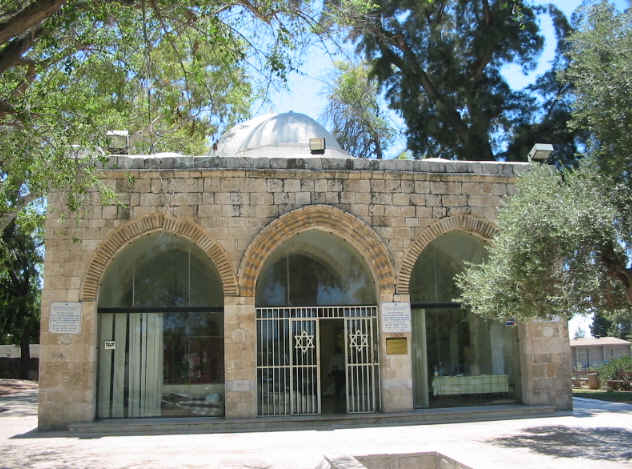|
Simeon Ha-Pakoli
Simeon ha-Pakoli (Hebrew: שמעון הפקולי) was a rabbi who lived in the late 1st century (second generation of tannaim). He was a contemporary of Rabban Gamaliel II at Jabneh. He arranged the eighteen blessings of the Shemoneh Esreh The ''Amidah Amuhduh'' ( he, תפילת העמידה, ''Tefilat HaAmidah'', 'The Standing Prayer'), also called the ''Shemoneh Esreh'' ( 'eighteen'), is the central prayer of the Jewish liturgy. Observant Jews recite the ''Amidah'' at each o ... prayer in the sequence in which they have been handed down. The name "Pakoli" is said to have been derived from Simeon's occupation, which was that of a dealer in flax and wool.Rashi on Berachot 18a Nothing further is known concerning him. References * {{Tannaim Mishnah rabbis ... [...More Info...] [...Related Items...] OR: [Wikipedia] [Google] [Baidu] |
Rabbi
A rabbi () is a spiritual leader or religious teacher in Judaism. One becomes a rabbi by being ordained by another rabbi – known as '' semikha'' – following a course of study of Jewish history and texts such as the Talmud. The basic form of the rabbi developed in the Pharisaic (167 BCE–73 CE) and Talmudic (70–640 CE) eras, when learned teachers assembled to codify Judaism's written and oral laws. The title "rabbi" was first used in the first century CE. In more recent centuries, the duties of a rabbi became increasingly influenced by the duties of the Protestant Christian minister, hence the title " pulpit rabbis", and in 19th-century Germany and the United States rabbinic activities including sermons, pastoral counseling, and representing the community to the outside, all increased in importance. Within the various Jewish denominations, there are different requirements for rabbinic ordination, and differences in opinion regarding who is recognized as a rabbi. For ex ... [...More Info...] [...Related Items...] OR: [Wikipedia] [Google] [Baidu] |
Tannaim
''Tannaim'' ( Amoraic Hebrew: תנאים , singular , ''Tanna'' "repeaters", "teachers") were the rabbinic sages whose views are recorded in the Mishnah, from approximately 10–220 CE. The period of the ''Tannaim'', also referred to as the Mishnaic period, lasted about 210 years. It came after the period of the ''Zugot'' ("pairs"), and was immediately followed by the period of the '' Amoraim'' ("interpreters"). The root ''tanna'' () is the Talmudic Aramaic equivalent for the Hebrew root ''shanah'' (), which also is the root-word of ''Mishnah''. The verb ''shanah'' () literally means "to repeat hat one was taught and is used to mean "to learn". The Mishnaic period is commonly divided up into five periods according to generations. There are approximately 120 known ''Tannaim''. The ''Tannaim'' lived in several areas of the Land of Israel. The spiritual center of Judaism at that time was Jerusalem, but after the destruction of the city and the Second Temple, Yohanan ben Zakkai an ... [...More Info...] [...Related Items...] OR: [Wikipedia] [Google] [Baidu] |
Gamaliel II
Rabban Gamaliel II (also spelled Gamliel; he, רבן גמליאל דיבנה; before -) was a rabbi from the second generation of tannaim. He was the first person to lead the Sanhedrin as ''nasi'' after the fall of the Second Temple in 70 CE. He was the son of Shimon ben Gamaliel, one of Jerusalem's foremost men in the war against the Romans, and grandson of Gamaliel I. To distinguish him from the latter he is also called Gamliel of Yavne. Biography He seemed to have settled initially in Kefar 'Othnai in Lower Galilee, but with the outbreak of the war with Rome, he fled to Jerusalem. From there, he moved to Yavne. In Yavne, during the siege of Jerusalem, the scribes of the school of Hillel had taken refuge by permission of Vespasian, and a new centre of Judaism arose under the leadership of the aged Johanan ben Zakkai, a school whose members inherited the authority of the Sanhedrin of Jerusalem. He was appointed ''nasi'' in approximately the year 80 CE. Leadership Gamal ... [...More Info...] [...Related Items...] OR: [Wikipedia] [Google] [Baidu] |
Jabneh
Yavne ( he, יַבְנֶה) or Yavneh is a city in the Central District of Israel. In many English translations of the Bible, it is known as Jabneh . During Greco-Roman times, it was known as Jamnia ( grc, Ἰαμνία ''Iamníā''; la, Iamnia); to the Crusaders as Ibelin; and before 1948, as Yibna ( ar, يبنى). History Yavne was one of the major ancient cities in the southern coastal plain, situated south of Jaffa, north of Ashdod, and east of the Mediterranean.Moshe Fischer, Itamar Taxel and David AmitRural Settlement in the Vicinity of Yavneh in the Byzantine Period: A Religio-Archaeological Perspective Bulletin of the American Schools of Oriental Research, No. 350 (May, 2008), pp. 7-35. Excavations were carried out on the ancient tell (mound created by accumulation of archaeological remains) known as ''Tel Yavne'' (Hebrew), which developed on a natural kurkar_hill._The_tell_was_inhabited,_possibly_continuously,_from_either_the_Bronze_or_Iron_Age_until_the_Mandat ... [...More Info...] [...Related Items...] OR: [Wikipedia] [Google] [Baidu] |
Amidah
The ''Amidah Amuhduh'' ( he, תפילת העמידה, ''Tefilat HaAmidah'', 'The Standing Prayer'), also called the ''Shemoneh Esreh'' ( 'eighteen'), is the central prayer of the Jewish liturgy. Observant Jews recite the ''Amidah'' at each of three daily prayer services in a typical weekday: morning (''Shacharit''), afternoon (''Mincha''), and evening (''Ma'ariv''). On Shabbat, Rosh Chodesh, and Jewish festivals, a fourth ''Amidah'' (''Mussaf'') is recited after the morning Torah reading, and once per year a fifth ''Amidah'' (''Ne'ilah'') is recited, around sunset on Yom Kippur. Due to its importance, in rabbinic literature it is simply called ''hatefila'' (, 'the prayer'). According to legend, the prayer was composed by the Rabbis of the Anshei Knesset HaGedolah (c. 515-332 BCE). Accordingly, in Judaism, to recite the ''Amidah'' is a '' mitzvah de-rabbanan''. Although the name ''Shemoneh Esreh'' ("eighteen") refers to the original number of component blessings in the ... [...More Info...] [...Related Items...] OR: [Wikipedia] [Google] [Baidu] |


